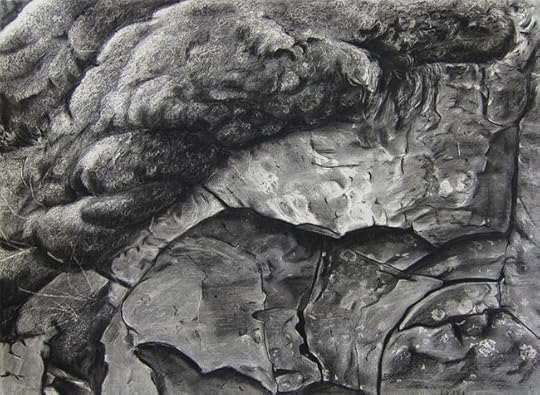Between the Rocks and a Soft Place
Moss, Lichen, Rocks 1, Thingvellir. Charcoal drawing, 30 x 22." Click image for larger view. or watch a slideshow of the drawing in progress.
This is an excerpt from a journal-manuscript I'm working on:
Why is it so hard to begin again? I started this drawing on March 8, over two months ago. In two days this week, I finished it, but only after weeks of procrastination. Why? It's not that it wasn't clear what needed to be done when I left off, before the apartment réparations began, or that I had forgotten. Each day I walked past the drawing, where it was pinned to the wall, not once but several times. It was en route to the plants which needed water or trimming, en route to the litter box, the bicycle pump, the vacuum cleaner and broom, the big papercutter and wall-mounted mat cutter that I had used several times over the past months to mat and frame relief prints. I kept the drawing carefully on the edge of my peripheral vision as I dragged a string for the cat to chase, or turned the oxalis and angel-wing begonia to face the light, or trimmed the rosemary and laid out the little branches on a paper towel to dry, never stopping to square my shoulders to the wall and confront its insistent presence.
I wanted to, though. That's the thing I don't understand. In general, for me, it's only beginning that's hard, making the start, taking that leap across the paralyzing abyss. I've learned to trust, now, that once I begin, I'll figure out a way through, even if I get lost in the forest for a while, and that I'll learn something along the way. The end result doesn't matter to me so much anymore. It isn't weighted the way it was when I was younger and had less time for art, or when I was always judging, judging...myself, and what other people might think, as if failure was always right around the next bend. And that strikes me as an odd grace, that now, when I'm so much more aware of the fleeting nature of time and how little may remain, it opens up because I'm learning to let go.
So one morning this week I cleaned off the drawing table, putting away the copies of our filed citizenship applications, the Croix Bleue folder full of insurance forms, the GST and QST tax worksheets. The table was dusty on the edges, and I swept it clean with a drafting brush and ran a damp sponge over the surface and polished it off with a paper towel. Then I replaced the large sheets of paper I like to keep underneath my work, to give a slightly softer working surface than the melamine-covered wood, and finally went over to the drawing, unpinned it, and laid it on the table. Beside it I set a box of compressed charcoal, and another of soft willow charcoal, a thick white eraser, a pen-like holder with a thin, round, white eraser core.
And the conversation commenced, as it does with ingredients laid on the kitchen counter; the drawing again became a living thing with which I was about to interact, as I decisively laid it there and addressed it with what - a prayer? A command? -- I don't know what that moment of beginning really is, or what we say to the blank or unfinished page, or what it says to us. There is a that moment, though, in its unwritten language, a breath or two, then decision: I choose a tool, take a piece of charcoal in my hand, and make a series of quick marks, there, and the past disappears.
---
Every drawing or painting ends up involving some sort of obstacle; when they don't, you know you're getting repetitive. In this one, the difficulty was in finding a way -- a shorthand, in effect -- for depicting the soft texture of the sphagnum moss in contrast to the hard surface of the underlying rocks. The rocks were easier, and in the end I even simplified them further and further, rubbing out decades of previously-drawn lichen-growth with the side of my hand.
For the moss I decided to try making an all-over scribbling pattern of little circles, first with a hard, fairly sharp black charcoal stick. What had to come across was the thickness and softness of the rounded sphagnum mat above the smooth rocks. The scribbled black texture alone, even over a background that had been shaded to indicate the pattern of light that defined the curves, wasn't enough. I began again,this time working from dark to light with the small pointed eraser, removing pigment in the same small circular pattern, keeping the lines as loose as I could, and finally the forms took shape: a calligraphy of moss.





